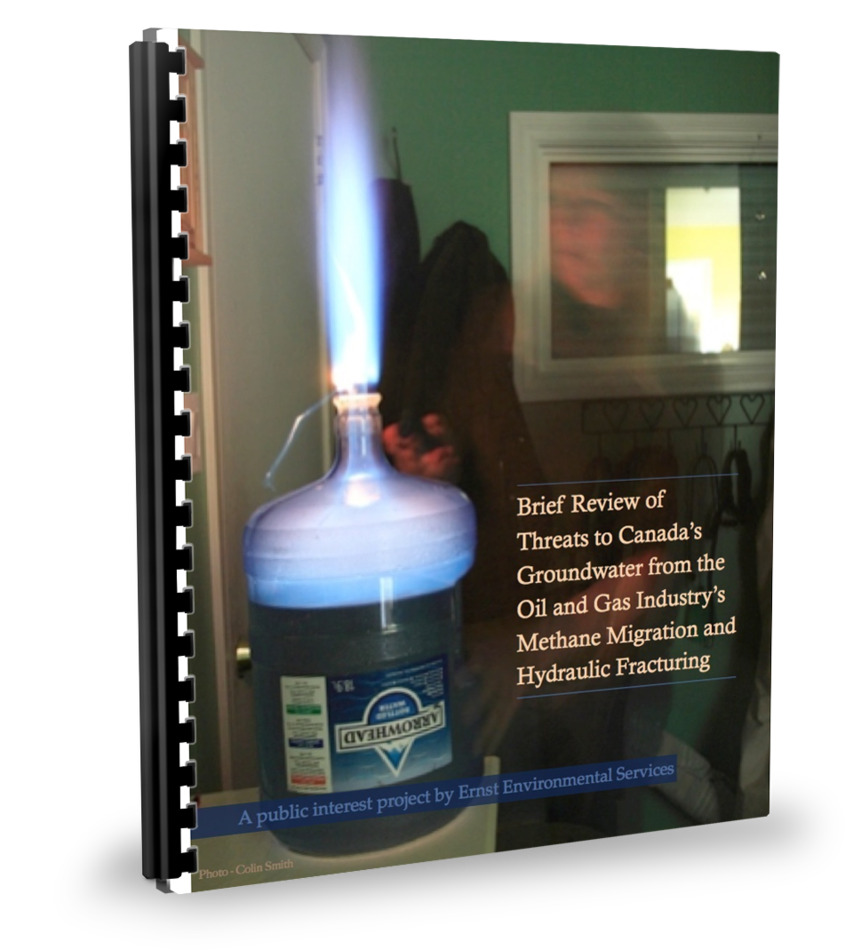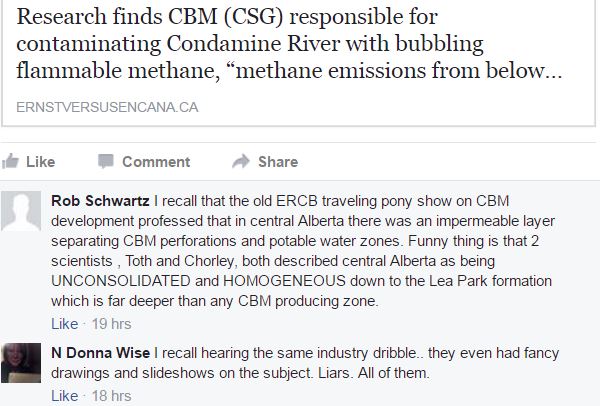Comments to posting of this post to Alberta Surface Rights Group Facebook Page:
Melbourne research into Condamine River bubbling and CSG by Queensland Country Life, 18 Apr 2017
THE affects of coal seam gas (CSG) extraction causing the Condamine River to bubble are far from over with new research finding that methane emissions from below ground could increase significantly.
The Condamine River made headlines last year when footage was released showing huge flames erupting from methane gas bubbling to the surface.
Greens MP Jeremy Buckingham was captured waving a kitchen lighter over the side of a tinny boat, starting a fire.
Now a report by the Melbourne Energy Institute has found that due to the thin and absent sealing layer of “aquitard” in the Surat Basin depressurisation from CSG mining could lead to widespread methane leakage.
[Sealing Layer Reality Check! The “Sealing Layer” is just another frac lie used in most CBC/CSG and shale gas and oil fields!
The regulators and “experts” have known this for decades, but keep enabling more and more fracing and contamination.
Half a year after Encana had already illegally fractured directly into Rosebud’s drinking water aquifers and secretly frac’d many other wells above the “impermeable layer,” Encana manager Mark Taylor (now VP at — you guessed it — the AER) promised Rosebud that the company would only ever frac far below the community’s drinking water aquifers and far beneath the “impermeable layer” to protect our water from natural gas migrating into it. Just another pathetic liar!]
Due to limited information, it is unknown how effective the aquitard is in preventing gas leaking to the atmosphere.
Continued depressurisation of the coal seams while users are extracting water from various aquifers could significantly increase the emissions.
The Australia Institute’s Matt Grudnoff said the research revealed previously unmeasured information that could be detrimental to the Paris Agreement.
He said it was appalling that the CSG industry had been allowed to go about work without proper assessment of the potential greenhouse gas emissions.
“In light of this report, the Queensland Government should be taking urgent action to prevent further CSG drilling until the serious risks identified in this report have been addressed,” he said. [Ha! Don’t hold your breath waiting for that]
The Australian Petroleum Production & Exploration Association (APPEA) Queensland Director Rhys Turner said they would work with researchers to help them better understand the nature of the seeps and the success of mitigation programs. [TOO LATE!]
“The fact is that the industry has been monitoring the Condamine River seeps since they were first observed to have increased in 2012 and continues to work with independent researchers including the CSIRO to better understand the local geology and possible causes,” he said. [But they keep fracing! What good is the monitoring when the seeps keep spreading and getting worse?]
“Industry data and CSIRO measurements show that peak rates of late 2015 to early 2016 have reduced substantially and we recently saw the lowest measurement since recordings began in 2013, a reduction of over 60% in the last 6 months.”
But anti-CSG activist Karen Auty of Chinchilla said the research findings weren’t new to locals.
“It doesn’t take a hydrogeologist or an expert to tell you that if you create a void by sucking out millions of gallons of water than something will take up the void,” she said.
“It won’t supply the answers. My simplest question to Origin is why is there no mention of the bubbling river phenomenon in the environmental impact statement? Surely someone would have noticed it.”
Limited data meant it was difficult to assess the full scale of the risk of the emissions during the research. [Emphasis added]
[Refer also to:
Ronalie Campbell comment at a formal hearing which included discussions on their methane/ethane/propane/butane/pentane dangerously contaminated drinking water:
At a hearing with a local oil company and government official present, the oil rep blurted out “it wasn’t us, it was Encana, CNRL, and all those others before us that blew the cap rock to hell.”
2011 08 03: Australian Petroleum Association: Coal seam damage to water inevitable
The coal seam gas industry has conceded that extraction will inevitably contaminate aquifers. “Drilling will, to varying degrees, impact on adjoining aquifers,” said the spokesman, Ross Dunn. “The intent of saying that is to make it clear that we have never shied away from the fact that there will be impacts on aquifers,” Mr Dunn said.
2012 05 30: Bubbling river blamed on Coal Seam Gas (Coal Bed Methane)
2012 – 2013 06: Submissions to Regulators of the Ernst Gas Migration Paper
Submissions of the Ernst Gas Migration Paper:
Earlier editions of this report were submitted:
The New York Department of Environmental Conservation January 11, 2012
The Québec Évaluation Environnementale Stratégique (ÉES) sur le Gaz de Schiste January 15, 2012
June 17, 2013 to Council of Canadian Academies Expert Panel reviewing frac impacts
June 17, 2013 to Wheatland County Council
June 18, 2013 to Rocky View County Council
Please specify if your new law’s exemption for 50,000 litre injections or less is per stage or all stages of a frac, per individual perforated zone or total injections via all perforations in a well bore, and how often a company can legally inject 50,000 litres of frac fluid at different time intervals into the same perforation of a well bore.
June 26, 2013 to Lancashire County Council
The Science is Deafening
Industry’s Contamination Everywhere
Regulator and Protective Agencies Run for Cover
Date (2013)
June 13 EES Gas Migration paper submitted to UK Department of Enterprise, Trade & Investment, Oil and Gas Licensing
June 14 ERCB closes the Campbell’s (Alberta ranchers) drinking water contamination investigation after 8 years of investigation*
June 15 Encana misses their promised deadline to file Statement of Defence on the Ernst vs Encana case after being served April 2011
June 16 BC Tap Water Alliance, FrackingCanada and Ami(s) du Richelieu broadcast the EES Gas Migration paper globally
June 17 EES Gas Migration paper submitted to Council of Canadian Academies expert panel reviewing frac’ing; report due soon
June 18 US EPA announces 2 year delay of comprehensive frac study
June 20 US EPA pulls out of Pavillion water contamination investigation after 4 years;Encana takes over with $1.5 million donation
June 24 Duke Study #2 on drilling and frac’ing causing methane contamination of groundwater published online, affirms Study #1
Duke Study #1 reported 17x more methane in groundwater near drilled and frac’d wells, published online May 9, 2011.
EES = Ernst Environmental Services
Yet CAPP’s Alex Ferguson says many worries about water quality are based on past operations involving coal-bed methane — shallow deposits in closer proximity to groundwater. These did occasionally contaminate water resources, he says. In some of the more infamous instances, affected landowners could light their well water on fire.
Alex Ferguson was appointed Commissioner and CEO of the BC Oil and Gas Commission from 2007-2011
***
A more sustainable way to power us:
2017 04 05: This German village generates 500% more energy than it needs
As Windpoldsreid’s Deputy Mayor, Günter Mögele, explained to the Financial Times: “I think people were surprised that the Energiewende is happening so fast,” and certainly it is not without it’s headaches for those looking at the issue on a national level. But Windpoldsried is a spectacular example of what can happen on a local level when residents and municipalities take matters into their own hands.

